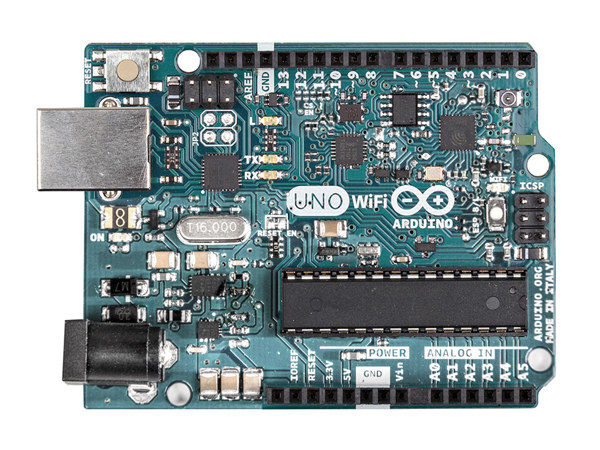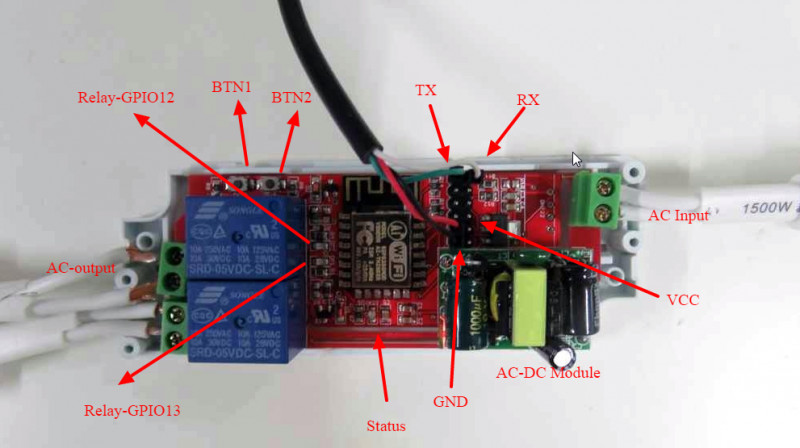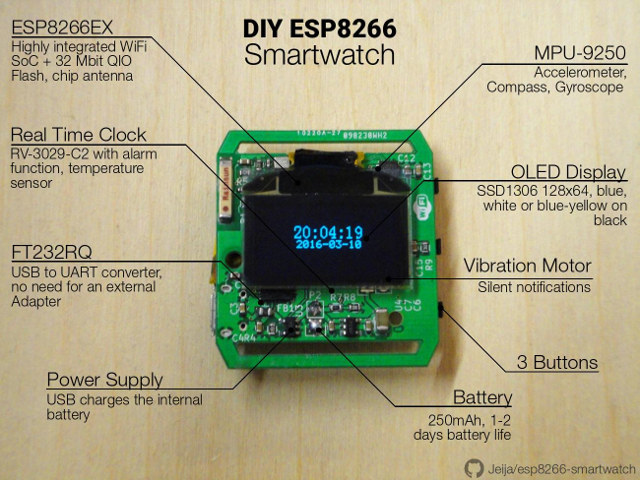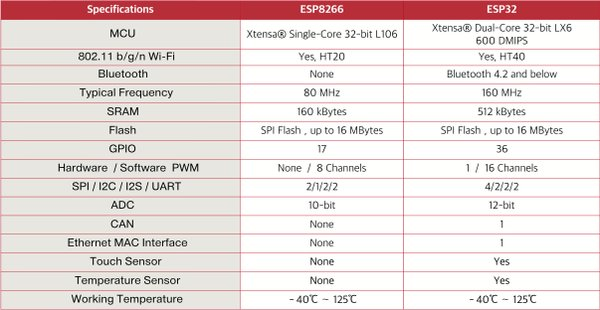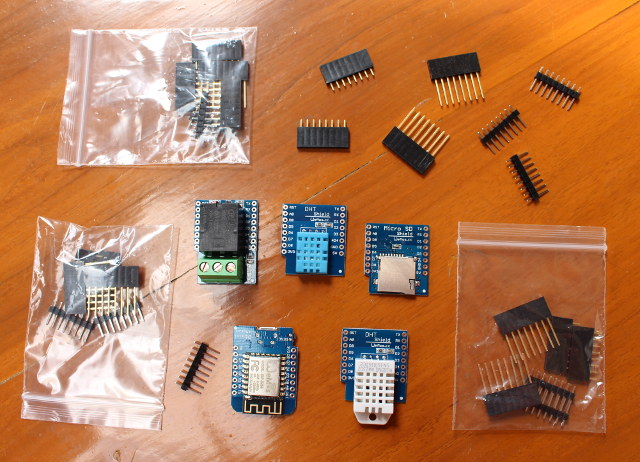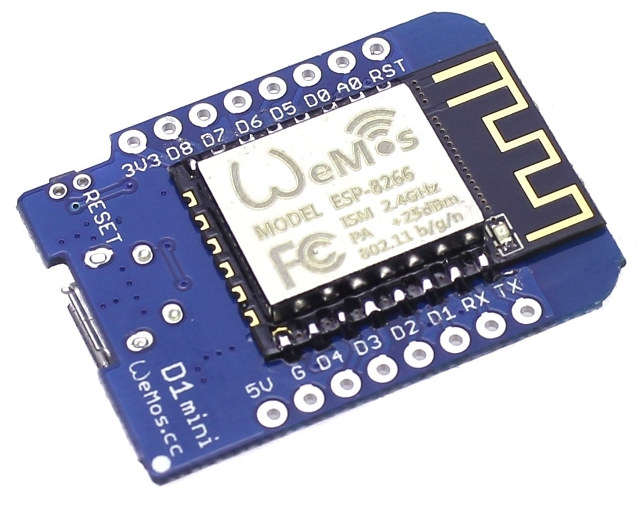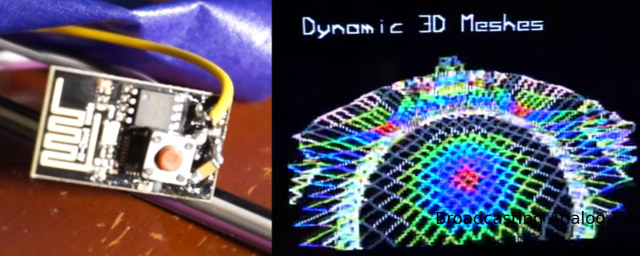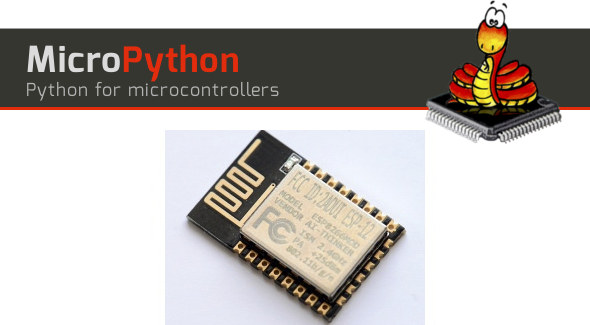Arduino.org (Arduino Srl) has launched Arduino UNO WiFi board, bringing Arduino (Atmel ATMega328P MCU) and ESP8266 together, and adding WiFi to the popular Arduino UNO board, while keeping all existing interfaces and headers. Arduino UNO WiFi (A000133) board specifications: Arduino part MCU – Atmel ATmega328 8-bit AVR MCU @ 16 MHz with 32 KB flash Memory, 2KB SRAM, 1KB EEPROM Digital I/O pins – 14, with 6 PWM and UART Analog Input Pins – 6 DC Current per I/0 – 40 mA Misc – Reset button Operating Voltage – 5 V ESP8266 part SoC – Expressif ESP8266EX Tensilica Xtensa LX106 processor @ 80 MHz Storage – 4MB SPI flash Connectivity – 802.11 b/g/n WiFi @ 2.4 GHz, wake up time < 2 ms; Antenna: PCB and IPX Misc – Bootloader button, WiFi LED Operating Voltage – 3.3 V Common specs USB – 1x USB device port Input Voltage – 5-12 […]
Electrodragon WiFi IoT Relay Includes ESP8266 Module, AC Power, and Enclosure for $6
Thanks to ESP8266, the cost of WiFi relays has dramatically come down, but so far, I could not find an all-in-one solution with ESP8266, relay, AC power and enclosure, and for example I’m still using NodeMCU board, a relay board, a USB power supply, and put all that into a plastic jar in order to control a water pump. It works but it’s not ideal, and solutions like Wemos D1 mini with relay shield improves things further, but Electrodragon has come with a connect-and-play WiFi IoT relay that integrates everything including the case for $6 + shipping. Wifi IoT Relay Board Based on ESP8266: WiFi module – ESP-12F based on Espressif ESP8266EX WiSoC Relays – 2x Songle SRD-05VDC-SL-C relays supporting 125VAC/10A, 250VAC/10A, 30VDC/10A, 28VDC/10A Input/Output – 3x terminal blocks for relay and power Expansion – 12-pin header with Rx/Tx, GPIO4, Btn2, GPIO15, 5V/GND, ADC, GPIO5, Btn1, OUTPUT1, and 3V3 Debugging […]
Learn How to Build Your Own Open Source Hardware ESP8266 Smartwatch
ESP8266 might be the cheapest WiFi SoC for IoT application available, but it’s not really renowned for its power efficiency, and is often not considered the best choice for battery powered applications. This has not stopped Jeifa from developing a WiFi smartwatch based on the chip, and the 250 mAh battery used in the design is said to be good enough for 1 or 2 days of operation on a charge. Main components of Jeija’s ESP8266 smartwatch: SoC – Espressif ESP8266 with 32Mbit of flash memory Display – SSD1306 OLED Display, 128×64 resolution Connectivity – 802.11 b/g/n WiFi (via ESP8266) Sensor – Invensense MPU-9250 gyroscope, accelerometer, and compass Debugging / Programming – FT232RQ for USB communication Misc RV-3029-C2 Real Time Clock with alarm function, and temperature sensor 3x user buttons Vibration Motor Power 250mAh LiPo battery MCP73831 LiPo charger Dimensions – 35 x 39 x 11mm (board) He designed the […]
ESP8266 and ESP32 Differences in One Single Table
Espressif Systems ESP8266 is a very popular platform for IoT applications relying on WiFi, at least for hobbyists, while Espressif ESP32 is the new solution from the company that adds a CPU core, faster WiFi, Bluetooth 4.2, and various I/Os which should launch very soon. Amica.io released a table showing the main differences between the two processors which are expected to coexist in the market with ESP8266 used in the lower-cost segment, and ESP32 in applications requiring WiFi and Bluetooth, or some of the new interfaces. Some of the features were clearly listed when ESP32 was first announced, but for example, I was not aware that an Ethernet MAC, and a temperature sensor were built into the new SoC. Other interesting features for the new ESP32 processor include a touch sensor, and hardware PWM both of which are missing in ESP8266. The new dual-core processor also builds on existing features, […]
Getting Started with Wemos D1 mini ESP8266 Board, DHT & Relay Shields
Wemos D1 mini is an ESP8266 board that’s interesting thanks to its size, its low price ($4), micro USB power, its shields, and a documentation that looks fairly good. The board can be programmed with Arduino or Lua, and supports both serial and OTA programming. I’ve decided to give it a try and bought the board together with two temperature shields, a relay shield, and micro SD shield. I got all for $ 14.00 from Wemos Aliexpress shop, and it took about one month for delivery. I can also see they’ve recently released a new OLED shield selling for about $5. All shields were shipped inside their own anti-static bags. The pins are clearly marked on both side of the board and the shields. One side of the board features ESP8266 module. and the other side has CH340 serial to USB chip, and the reset button. The provided headers make […]
$4 Wemos D1 mini ESP8266 Board Supports Shields with a Temperature Sensor, a Button, a Relay, or a micro SD slot
Wemos D1 board, a $9 ESP8266 board in Arduino UNO form factor, now has a little brother with Wemos D1 mini. The board looks somewhat similar to NodeMCU with breadboard friendly I/Os on the sides and a micro USB port for power and programming, but what could make it more interesting, beside the $4 price tag, is that the company also developed several shields (aka add-on boards). Wemos D1 mini specifications: WiFi 802.11 b/g/n module based on ESP8266EX with 4MB flash Expansion – Through holes with 11x digital input/output pins (3.3V) supporting interrupt/PWM/I2C/one-wire (except D0) 1x analog input (3.3V max input) Reset and power signals (5V, 3.3V, GND) USB – micro USB port Misc – Reset button Power – 5V via micro USB or 5V pin Dimensions – 34.2 x 25.6 mm Weight – 10 grams The board is said to be compatible with Arduino IDE and NodeMCU firmware. ESP8266 […]
You Can Now Connect ESP8266 Module to Your Color Television (Sort of)
You can do lots of things with ESP8266 WiFi modules, but CNLohr did something rather unexpected as he managed to use GPIO3/RX pin to broadcast NTSC signals first in black & white, and now in color, to his television’s channel 3. On the hardware side, he did have to disconnect the WiFi antenna, and connected a wire antenna to GPIO3/RX pin. He then set I2S to run at 80 Mbps, and pushed data out using DMA buffers, so he could achieved the 61.25 MHz frequency required for NTSC luminance data, and the color data, 3.579MHz higher up. Once the demo is running, you can alter it on the fly using a web neat interface. This is all explained on channel3’s github repository, as well as one a 15-minute video showing the capabilities and limitations, and explaining how you can play around with the parameters. Via ESP8266COM’s Tweet. Jean-Luc Aufranc (CNXSoft)Jean-Luc […]
Bringing a Better Port of MicroPython to ESP8266 (Crowdfunding)
MicroPython is an lightweight implementation of Python 3 that runs on ARM Cortex-M micro-controllers such as STM32 or Texas Instruments CC3200, and since ESP8266 is so popular, work has started to port MicroPython on the Tensilica Xtensa LX106 based WiFi SoC. The current ESP8266 port comes with some API callss specific to ESP8266, but is quite basic, uses the execution model provided by Espressif, requiring callbacks to process WiFi requests, and doesn’t include support for many of the chip’s interface such as SPI, nor support WiFi fully. That’s why Damien George, the project lead, has launched a Kickstarter campaign to help fund development of the port, aiming to raise at least 6000 GBP (~$8,500 US). The goal is to develop “proper” Berkeley sockets for MicroPython on the ESP8266, in order to provide a true Python socket API to make development easier, optimize RAM usage, and implement the missing parts on […]


